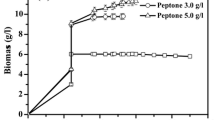Abstract
Ensuring a suitable pH is a major problem in industrial organic acid fermentation. To circumvent this problem, we used a metabolic profiling approach to analyze metabolite changes in Rhizopus oryzae under different pH conditions. A correlation between fumaric acid production and intracellular metabolic characteristics of R. oryzae was revealed by principal component analysis. The results showed that to help cell survival in the presence of low pH, R. oryzae altered amino acid and fatty acid metabolism and promoted sugar or sugar alcohol synthesis, corresponding with a suppressing of energy metabolism, phenylalanine, and tyrosine synthesis and finally resulting in the low performance of fumaric acid production. Based on this observation, 1 % linoleic acid was added to the culture medium in pH 3.0 to decrease the carbon demand for cell survival, and the fumaric acid titer was enhanced by 39.7 % compared with the control (pH 3.0 without linoleic acid addition), reaching 18.3 g/L after 84 h of fermentation. These findings provide new insights into the mechanism by which R. oryzae responds to acidic stress and would be helpful for the development of efficient strategies for fumaric acid production at low pH.





Similar content being viewed by others
References
Zhang, K., Yu, C., & Yang, S.-T. (2015). Effects of soybean meal hydrolysate as the nitrogen source on seed culture morphology and fumaric acid production by Rhizopus oryzae. Process Biochemistry, 50, 173–179.
Xu, Q., Li, S., Huang, H., & Wen, J. (2012). Key technologies for the industrial production of fumaric acid by fermentation. Biotechnology Advances, 30, 1685–1696.
Ding, Y., Li, S., Dou, C., Yu, Y., & Huang, H. (2011). Production of fumaric acid by Rhizopus oryzae: role of carbon–nitrogen ratio. Applied Biochemistry and Biotechnology, 164, 1461–1467.
Roa Engel, C. A. (2010). Integration of fermentation and cooling crystallisation to produce organic acids.
Wang, G., Huang, D., Qi, H., Wen, J., Jia, X., & Chen, Y. (2013). Rational medium optimization based on comparative metabolic profiling analysis to improve fumaric acid production. Bioresource Technology, 137, 1–8.
Zhou, J., Ma, Q., Yi, H., Wang, L., Song, H., & Yuan, Y.-J. (2011). Metabolome profiling reveals metabolic cooperation between Bacillus megaterium and Ketogulonicigenium vulgare during induced swarm motility. Applied and Environmental Microbiology, 77, 7023–7030.
Xu, Q., Li, S., Fu, Y., Tai, C., & Huang, H. (2010). Two-stage utilization of corn straw by Rhizopus oryzae for fumaric acid production. Bioresource Technology, 101, 6262–6264.
Meijer, S., Panagiotou, G., Olsson, L., & Nielsen, J. (2007). Physiological characterization of xylose metabolism in Aspergillus niger under oxygen‐limited conditions. Biotechnology and Bioengineering, 98, 462–475.
Ding, M.-Z., Wang, X., Yang, Y., & Yuan, Y.-J. (2012). Comparative metabolic profiling of parental and inhibitors-tolerant yeasts during lignocellulosic ethanol fermentation. Metabolomics, 8, 232–243.
Liu, Y., Lv, C., Xu, Q., Li, S., Huang, H., & Ouyang, P. (2015). Enhanced acid tolerance of Rhizopus oryzae during fumaric acid production. Bioprocess and Biosystems Engineering, 38, 323–328.
Beales, N. (2004). Adaptation of microorganisms to cold temperatures, weak acid preservatives, low pH, and osmotic stress: a review. Comprehensive Reviews in Food Science and Food Safety, 3, 1–20.
Zhou, J., Liu, L., & Chen, J. (2011). Improved ATP supply enhances acid tolerance of Candida glabrata during pyruvic acid production. Journal of Applied Microbiology, 110, 44–53.
Jamalzadeh, E., Verheijen, P. J. T., Heijnen, J. J., & van Gulik, W. M. (2012). pH-dependent uptake of fumaric acid in Saccharomyces cerevisiae under anaerobic conditions. Applied and Environmental Microbiology, 78, 705–716.
Jozefczuk, S., Klie, S., Catchpole, G., Szymanski, J., Cuadros‐Inostroza, A., Steinhauser, D., Selbig, J., Willmitzer, L. (2010). Metabolomic and transcriptomic stress response of Escherichia coli.
Diamant, S., Rosenthal, D., Azem, A., Eliahu, N., Ben-Zvi, A. P., & Goloubinoff, P. (2003). Dicarboxylic amino acids and glycine-betaine regulate chaperone-mediated protein-disaggregation under stress. Molecular Microbiology, 49, 401–410.
Krasensky, J., & Jonak, C. (2012). Drought, salt, and temperature stress-induced metabolic rearrangements and regulatory networks. Journal of Experimental Botany. doi:10.1093/jxb/err460.
Rodríguez-Vargas, S., Sánchez-García, A., Martínez-Rivas, J. M., Prieto, J. A., & Randez-Gil, F. (2007). Fluidization of membrane lipids enhances the tolerance of Saccharomyces cerevisiae to freezing and salt stress. Applied and Environmental Microbiology, 73, 110–116.
Fozo, E. M., & Quivey, R. G. (2004). Shifts in the membrane fatty acid profile of Streptococcus mutans enhance survival in acidic environments. Applied and Environmental Microbiology, 70, 929–936.
Li, L., Ye, Y., Pan, L., Zhu, Y., Zheng, S., & Lin, Y. (2009). The induction of trehalose and glycerol in Saccharomyces cerevisiae in response to various stresses. Biochemical and Biophysical Research Communications, 387, 778–783.
Jiang, L., Cui, H., Zhu, L., Hu, Y., Xu, X., Li, S., & Huang, H. (2015). Enhanced propionic acid production from whey lactose with immobilized Propionibacterium acidipropionici and the role of trehalose synthesis in acid tolerance. Green Chemistry, 17, 250–259.
Shen, B., Hohmann, S., Jensen, R. G., Bohnert, & Hans, J. (1999). Roles of sugar alcohols in osmotic stress adaptation. Replacement of glycerol by mannitol and sorbitol in yeast. Plant Physiology, 121, 45–52.
Acknowledgments
This work was financially supported by the National Natural Science Foundation of China (No. 21106065), the National Basic Research Program of China (No. 2013CB733605), National Science Foundation for Distinguished Young Scholars of China (No. 21225626), the National High Technology Research and Development Program of China (No.2011AA02A206), and the undergraduates innovating experimentation project from Nanjing Tech University (No. 2015 DC043).
Author information
Authors and Affiliations
Corresponding author
Rights and permissions
About this article
Cite this article
Liu, Y., Xu, Q., Lv, C. et al. Study of Metabolic Profile of Rhizopus oryzae to Enhance Fumaric Acid Production Under Low pH Condition. Appl Biochem Biotechnol 177, 1508–1519 (2015). https://doi.org/10.1007/s12010-015-1831-8
Received:
Accepted:
Published:
Issue Date:
DOI: https://doi.org/10.1007/s12010-015-1831-8




